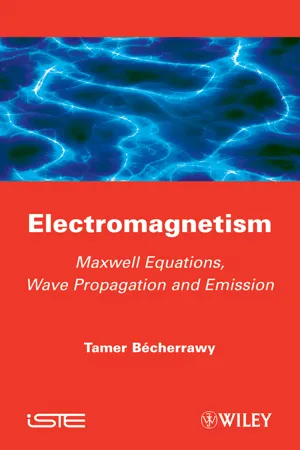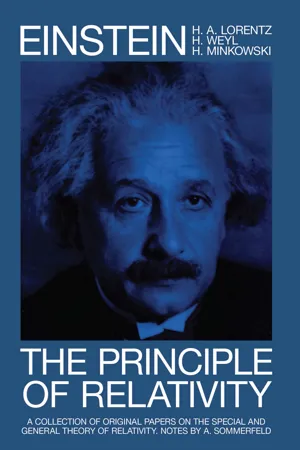Physics
Electromagnetic Momentum
Electromagnetic momentum refers to the momentum carried by electromagnetic fields. In classical electromagnetism, it is defined as the momentum density of the electromagnetic field. This concept is important in understanding the transfer of momentum between electromagnetic fields and matter, as well as in the study of electromagnetic waves and their interactions with matter.
Written by Perlego with AI-assistance
Related key terms
Related key terms
1 of 4
Related key terms
1 of 3
3 Key excerpts on "Electromagnetic Momentum"
- eBook - ePub
Electromagnetism
Maxwell Equations, Wave Propagation and Emission
- Tamer Becherrawy(Author)
- 2013(Publication Date)
- Wiley-ISTE(Publisher)
Show that, at low frequency (ω << b / m e), they tend to a terminal velocity v = − e E / b. Show that the electrons are subject to a magnetic force F M = (e 2 /2 b) EB pointing in the direction Oz. d) This force may be assimilated to a radiation pressure. Show that it is equivalent to a rate of transfer of momentum δ p = (e 2 / b) EB per electron and per unit time. Show that the work exerted by the electric field on the electron in motion is δ W = (e 2 / b) E 2. Verify that, in the case of an electromagnetic wave in vacuum, δ W = c δ p. This is the relationship between the energy density and the momentum density of the wave or between the energy and the momentum of the photons that are associated with the wave and absorbed by the metallic plate. P10.30 The ground state energy of the hydrogen atom is E 1 = −13.6057 eV and its first excited level is at E 2 = −3.4014 eV. What is the wavelength of the emitted radiation in the transition from E 2 to E 1? What should the kinetic energy of an electron, which collides with the atom, be in order to excite it from the ground state to the level E 2? What should this kinetic energy be in order to ionize the atom from the ground state? 1 The amplitudes A 1 and A 2 are positive. The waves may have the phases φ 1 and φ 2, then φ = φ 2 −φ 1. Taking φ 1 = 0 is equivalent to changing the origin of time. 2 In some domains of physics, reversed conventions are used for right-handed or left-handed polarization. - Andreas Braeuer(Author)
- 2015(Publication Date)
- Elsevier(Publisher)
Fig. 2.1 .Figure 2.1 Classification of different interaction mechanisms of matter and electromagnetic radiation.2.1. Properties of electromagnetic radiation and photons
Here the basics about electromagnetic radiation are provided, which are relevant for understanding the interaction mechanisms of matter and electromagnetic radiation addressed in this book. In detail I describe for a harmonic wave, which features a sinusoidal profile, the wavelength, the phase, the frequency, the wavenumber and the polarisation. We will see in the chapters that follow that under certain circumstances the interpretation of electromagnetic radiation in terms of photons is more elegant than in terms of harmonic waves. Therefore Section 2.1.4 provides the energy and the momentum of photons.2.1.1. Equation of a Harmonic Wave
The wave functionΨ ( x , t ) = A ⋅ sin ( k ( x ± c t ) ) = A ⋅ sin ( k x ± ω t )(2.1)of a wave with a sinusoidal profile propagating with time t along the x -direction with a speed of propagation c is shown in Fig. 2.2 . A is the amplitude of the wave, which is the maximum value of the magnitudeΨ ( x , t )- eBook - ePub
- Albert Einstein, Francis A. Davis(Authors)
- 2013(Publication Date)
- Dover Publications(Publisher)
.The case of molecular motion will be considered in § 12 .It will easily be seen that the hypothesis which was formerly advanced in connexion with Michelson’s experiment, is implied in what has now been said. However, the present hypothesis is more general, because the only limitation imposed on the motion is that its velocity be less than that of light.§ 9. We are now in a position to calculate the Electromagnetic Momentum of a single electron. For simplicity’s sake I shall suppose the charge e to be uniformly distributed over the surface, so long as the electron remains at rest. Then a distribution of the same kind will exist in the system Σ′ with which we are concerned in the last integral of (22) . HenceandIt must be observed that the product β l is a function of υ and that, for reasons of symmetry, the vector G has the direction of the translation. In general, representing by v the velocity of this motion, we have the vector equationNow, every change in the motion of a system will entail a corresponding change in the Electromagnetic Momentum and will therefore require a certain force, which is given in direction and magnitude byStrictly speaking, the formula (28) may only be applied in the case of a uniform rectilinear translation. On account of this circumstance—though (29) is always true—the theory of rapidly varying motions of an electron becomes very complicated, the more so, because the hypothesis of § 8 would imply that the direction and amount of the deformation are continually changing. It is, indeed, hardly probable that the form of the electron will be determined solely by the velocity existing at the moment considered.Nevertheless, provided the changes in the state of motion be sufficiently slow, we shall get a satisfactory approximation by using (28) at every instant. The application of (29) to such a quasi-stationary translation, as it has been called by Abraham,* is a very simple matter. Let, at a certain instant, a 1 be the acceleration in the direction of the path, and a 2 the acceleration perpendicular to it. Then the force F
Index pages curate the most relevant extracts from our library of academic textbooks. They’ve been created using an in-house natural language model (NLM), each adding context and meaning to key research topics.
Explore more topic indexes
Explore more topic indexes
1 of 6
Explore more topic indexes
1 of 4


